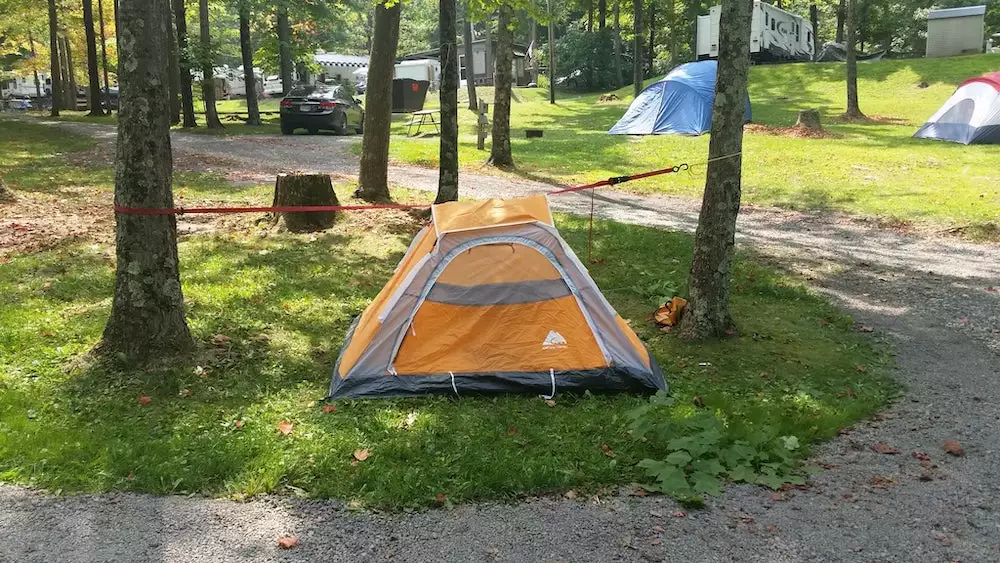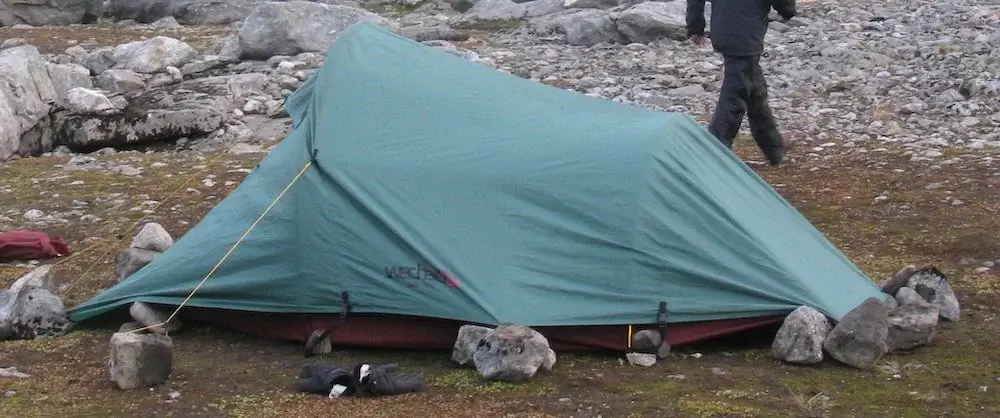How to secure a tent without stakes? On a camping trip, it’s always important to know how to secure your tent. You may have some stakes that are just lying around the campsite for this purpose, but what if you don’t?
Camping isn’t all about roughing it – sometimes there are too many pesky bugs. That’s why we’ve put together this list of 6 different ways to keep your tent in place without resorting to traditional methods.
Method One: Weights
One way to secure your tent is by using weights. These can be anything from rocks to logs, and they will help keep the tent grounded in windy conditions.
Make sure that you spread the weight out evenly, and don’t put all of it on one side or corner of the tent. This could cause the tent to collapse.
Method Two: Sandbags & Water Jugs
Another great way to secure your tent is with sand or water jugs! Fill them up, then place them on the corners of your tent for some extra weight that will keep it in place even when there’s a lot of wind and rain outside. You could even use this method if you don’t have stakes!
Method Three: Tent Pegs
If you have some stakes, try using them to secure your tent. It’s especially vital in strong winds, as the stakes will help keep the tent’s fabric from flapping around and becoming damaged.
Make sure that you hammer them into the ground properly not to come loose.
Method Four: Stakeless Tent Pegs
If you’re searching for a more straightforward method to put up your tent, try using stakeless tent pegs! These nifty little gadgets attach to the corners of your tent and use tension instead of stakes to keep it in place.
They’re great if you don’t have stakes or sandbags, and they can also be used in windy conditions.
Method Five: Rope & Tarp Clips
If your camping spot has trees nearby, try rope to secure your tent. For example, you could tie it around the trunk of a tree, then attach clips made from carabiners to your tent.
This will make it harder for the wind and other elements to move your tent around, especially if you’re camping somewhere exposed like a beach or field.
Method Six: Bungee Cords & Clothesline Rope
Bungee cords are also helpful in keeping your tent down. You can use them to attach the corners of your tent to nearby objects, like trees or poles.
This will provide a better seal and prevent the wind from entering. If you don’t have any bungee cords handy, try using clothesline rope instead!
What You Need to Do to Ensure Your Tent Is Stable

- Use rocks or logs to keep the tent in place.
- Dig trenches around the perimeter of your tent and fill them with water.
- Put sandbags on the corners of the tent.
- Strap the tent down to stakes or poles using rope or bungee cords.
- String ropes between trees and attach the tent to the ropes.
- Use a tent footprint or circle of rocks instead of stakes.
- Put your shoes inside the tent and fill them with sand for added weight.
- Anchor one end of an anchor chain between two trees then attach the other ends around your tent’s tie-down points, such as its peak and sides. Note: this method is the most effective.
- Use your trekking poles to secure the tent’s corners and tie-down points. Or, you can use rocks or logs instead of stakes for added security on windy days.
- Fold your rain fly over your tent at night to weigh it down in case there are strong winds. If you don’t have a rain fly, use a tarp or blanket.
- If you’re still having trouble keeping your tent in place, consider using a ground cloth to help keep the bottom of your tent from moving around. And remember to always pack extra stakes just in case.
Also Read: 3 Season vs. 4 Season Tent: Which One Should You Choose?
How to Ensure That Your Camping Trip Is a Success

– If there are rocks or other objects available, use them to weigh down the corners of your tent.
– If it’s a windy day, try to find a sheltered spot to set up camp.
– Use logs, branches, or rocks to create a makeshift fence around the perimeter of your campsite.
– If you have a tarp or rainfly, make sure to secure the base of your tent down with it.
– Use paracord and carabiners to tie the corners of your tent off securely. The goal is for them not to move at all if possible!
– Ensure that there are no gaps between where the tent meets the ground. If there are, use a piece of cloth, plastic, or even snow to fill them in.
– Stuff sacks can be used as extra weight on the corners of your tent if needed.
– If you’re stuck and don’t have anything else to use, try using sand or dirt to help weigh down your tent. Just be sure to clean it all up before you leave!
– And last but not least, always check the forecast and plan your trip accordingly! It’s no fun getting stuck in a storm when you’re miles away from home.
Frequently Asked Questions (FAQs):
How much weight is required to keep a tent from blowing away?
It varies depending on the size and type of tent, but in general, you’ll need at least 15-30 pounds to hold down a standard camping tent. For larger tents or those used in windy conditions, you’ll need more weight. Of course, the tent’s weight and its contents should be considered as well.
What is the best way to stabilize a pop-up canopy?
A pop-up canopy doesn’t have the floor and isn’t meant to be used in windy conditions, so you don’t need to worry about the weight.
However, it does come with tie-downs that can secure it from blowing away or weights such as sandbags or water jugs which you should place around the bottom edges of each leg.
How can I keep my beach tent from blowing away?
Beach tents are typically lightweight and made to be used in windy conditions, so they don’t require a lot of weight. However, you can use sandbags or water jugs around the bottom edges of each leg to keep it from blowing away.
Can I use rocks to weigh down my tent?
Rocks can work in a pinch, but they’re not the best option. They can shift and roll, which could damage your tent or injure someone. It’s also difficult to get an even distribution of weight with rocks.
Conclusion
Camping can be a lot of fun, but it’s important to make sure your trip is successful. By using some of these tips, you’ll be able to secure your tent without stakes and keep it from blowing away in the wind. Happy camping!
If you’re still having trouble keeping your tent in place, consider using a ground cloth to help keep the bottom of your tent from moving around.

